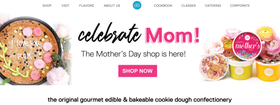How to Build Brand Recall in a Clickless World
Brand awareness is dwindling in organic search. Here's your strategy for building brand equity and recall by leveraging brand awareness. Learn more here.
Read More
Brand identity isn’t just a logo or an advertising campaign; it’s the way a brand presents itself to the market and interacts with its audience. It covers everything from product design to audience targeting, employee relations, and customer support. There's no aspect of a company that’s not a part of its brand identity.
Let’s look at the top 10 elements that you should address to create a strong brand identity, from the most basic to the more complex.
A name identifies, differentiates, and reflects the essence of the owner, and the same is true for brands. The brand name is the company’s first impression; it’s strengthened by good customer experiences and destroyed by bad ones. Choosing a name isn’t a straightforward process, so it helps to follow a few basic principles to make sure the name advances the overall brand strategy:
Be simple. While sophisticated wordplay might be tempting, it’s more important to be understood. A good brand name is easy to pronounce and conveys the brand’s purpose and character. When part of a broad, rich brand strategy, even the simplest names are the most powerful. Think Apple, Facebook, or Toys “R” Us.
Be memorable. The strongest memories are emotion-based, and powerful brand names do an excellent job of conveying emotion. For example, Land Rover taps into a sense of adventure and escape.
Be original. A strong brand name must be one of a kind, and that’s a tough ask in a saturated global marketplace. Yet, there are many ways to convey originality. For example, did you know that the brand name IKEA is an acronym of the founder’s name and hometown?
Part of building a strong brand identity is boosting brand awareness and perception, and this can only be done correctly by targeting the right audience. For example, if the target audience is new mothers, a brand will naturally focus its advertising strategy on parenting websites and online wellness forums. If the audience is teenagers, it might include native ads on gaming sites or sports channels. According to the Content Marketing Institute, 90% of top-performing B2B content marketers focus on what information the audience needs, rather than what the brand wants to say.
Having a deep understanding of who your audience is, what matters to them, and what their needs and challenges are should directly shape a company’s brand — from the visual design to the development of a brand’s core values. Everything should center around the target audience.
Neuroscientific research at MIT demonstrated that the brain could process images in 13 milliseconds, and logos provide instant brand recognition. The world’s most famous brands are recognizable by their logo alone, which is why companies place so much importance (and so many resources) in logo development. BP spent millions of pounds introducing its new sunflower logo to the market, and it was still met with controversy.
A brand logo should be instantly recognizable: simple, unique, appropriate, and memorable. Most importantly, it should clearly convey the company’s messaging. Companies should also consider the various sizes and shapes their logo will be expected to take, from website headers to products to stationary. Make sure the logo either scales easily or comes in variations that fit common shapes and media.

Bet you can recognize this logo.
Strong brand identity comes from high design standards applied consistently in every aspect of the brand’s strategy — from office design to product packaging, web design, and social media posts. This is achieved with a brand style guide or brand book. A solid brand book consists of a wide range of information governing the brand’s precise look and feel: font types and sizes, brand colors, logo design and size, layout rules, and more. Small discrepancies in design can erode brand identity, even seemingly trivial matters — such as letter spacing of the brand name — can have a negative effect. A brand book can help prevent that from happening.
A critical element of any brand strategy is defining the brand’s unique value proposition (UVP). The UVP describes how the brand is different from its competitors, its benefit to customers, and how it solves their pain points. By clearly outlining the brand’s value offering, the UVP also establishes the brand’s positioning in the market. A UVP doesn’t need to be complex or sophisticated, but it should be clear and descriptive.
Take the UVP of raw cookie dough maker, DŌ: “the original gourmet edible and bakeable cookie dough confectionery.” It clearly describes the product (“cookie dough confectionary”), its features (“edible and bakeable”), while positioning the brand as “the original” and “gourmet” in relation to competitors.

Check out DŌ's irresistible UVP.
An effective way to strengthen brand identity is by cultivating a market position as a thought leader. Thought leadership is when an individual or company is recognized as an authority in its field or niche. It’s a cost-efficient way to build a brand presence as it harnesses the inherent skill, talent, and charisma of the company’s team. Thought leaders are sought out for their expertise and opinions and often feature in articles, blog posts, industry journals, webinars, podcasts, live speaking events, TV, and more. Imagine Microsoft without Bill Gates or Tesla without Elon Musk. The good news for smaller businesses is that thought leaders don’t have to be world-famous to have a significant impact on brand strategy.
Every memorable brand stands for something, whether it’s something global like saving the environment or something specific like making clothes that fit every body shape. These brand values help the company focus its efforts towards a set of unified goals, often expressed as aspirational statements or promises. They also help to cement a brand in the minds of its target audience, giving them a powerful bonding tool with the people they hope to market to.
Failing to create and communicate brand values leads to brands that don’t really feel “alive” — brands that remain abstract and corporate, and don’t resonate with any audience. Some executives see this as a positive: If you don’t align yourself with any specific values, you won’t risk accidentally turning off any potential customers. Unfortunately, these companies also won’t attract any prospective customers and run the risk of creating a brand that doesn’t stand out from competitors.
Setting and communicating brand values is essential to creating a lasting brand image. The values a company picks should reflect the values of its audience and staff — they also have to be reflected in their marketing and their products. Most of all, any brand values a company espouses need to be held as sacred and unbreakable. Customers might shop with an organization that doesn’t have clear values, but they won’t shop with one that breaks their brand promises.
Over three-quarters of consumers make purchasing decisions because of the brand. That’s why it’s so important to cultivate brand memorability. It’s tempting to think that memorable brands are the ones appearing in Super Bowl ads or flashing on billboards in Times Square. That may be true of the world’s largest and most famous brands, but any brand can achieve memorability without spending millions of advertising dollars to do it. Brand memorability comes from some of the most basic strategies, such as excellent customer service and responsiveness, high product quality, and authentic marketing messages.
More and more brands realize the power of their employees in building a strong brand identity. Some of the statistics surrounding employee advocacy are truly impressive — brand messages shared by employees got 561% higher reach than those promoted by regular brand channels. Plus, employee advocacy contributed to a 65% increase in brand recognition. Employees of an organization are natural partners in brand marketing; they know the company inside out, and they have a personal stake in the brand’s success. In the best case, they’re loyal and proud of the brand, creating a positive flow of brand messaging to their social and personal networks. Employee advocacy is also prized for its high ROI — brands can boost their reach and exposure at minimal cost, simply by providing content for employees to share.
A strong brand identity is a coherent one. It provides a consistent, logical, and satisfying customer experience that fulfills the promise of the company’s unique value proposition. Of course, a key aspect of brand cohesion is making sure there's consistency in design across all marketing activities, such as websites, social media pages, and ad campaigns. Social ads can help make this easier. However, true brand cohesion is much more than that. It means not just fulfilling customers’ current needs and expectations, but anticipating new ones as they arise, and before the customers even realize they have them. Brand cohesion demands a flexible, integrated organizational infrastructure that supports this dynamic approach.
Brand identity is a broad concept, and it can be challenging to know where to begin. Let's start with your brand awareness stats — do people recognize or think of your brand when it comes to a specific category? If you're unsure of how to measure brand awareness, here are seven ways to get you started:
And if you need help with building brand awareness with the right shoppers or getting new high-quality traffic to your site, AdRoll can help.
Last updated on November 16th, 2023.